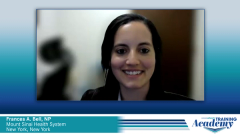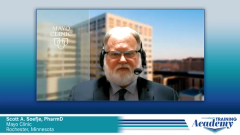
Multiple Myeloma: Overview of an Evolving Treatment Landscape
Moderator Cesar Rodriguez, MD, spearheads a discussion on the current state of the multiple myeloma treatment paradigm with a focus on bispecifics in the multiply relapsed setting.
Episodes in this series

Transcript:
Cesar Rodriguez, MD: Welcome to this Cancer Network® Training Academy session titled “Bispecifics in Multiple Myeloma: Payer Perspectives.” I’m your host, Cesar Rodriguez, and I’m an associate professor of medicine at the Icahn School of Medicine at Mount Sinai [in New York, New York] and the clinical director of multiple myeloma in the Mount Sinai system. I have a great panel of experts on the topic who have joined me, and I’d like to invite my esteemed fellow panelists to introduce themselves. We’ll start with Scott.
Scott A. Soefje, PharmD, MBA, BCOP, FCCP, FHOPA: Hi, my name is Scott Soefje. I am the director of pharmacy cancer care and an assistant professor at the Mayo Clinic in Rochester, Minnesota.
Cesar Rodriguez, MD: Franny?
Frances A. Bell, NP: Hi, I’m Franny. I’m a nurse practitioner at Mount Sinai, and I’ve been working here in the multiple myeloma department for the last 4 years.
Cesar Rodriguez, MD: And Kirollos?
Kirollos S. Hanna, PharmD, BCPS, BCOP: Thank you so much. I’m Kirollos Hanna. I’m the director of pharmacy at Minnesota Oncology. I’m also an assistant professor at the Mayo Clinic College of Medicine. I do a lot of my research in B-cell cancers as well as multiple myeloma, and I’m looking forward to today’s discussion.
Cesar Rodriguez, MD: Thank you all for joining us. We’re going to discuss the workflow in a health care system treating patients with bispecifics. We’ll share our experiences and best practices from a payer perspective regarding approvals of bispecifics, consents, health care proxies, supportive care agents, and transition of care—all the aspects that encompass managing a patient with a bispecific T-cell engager.
Before we jump into the actual bispecific and how we handle patients being treated with bispecifics, let’s give a little background about where bispecifics fit in at the moment in the myeloma landscape. Multiple myeloma is not curable yet, but it’s become a more chronic disease thanks to all the new therapies that have been FDA approved in the last 10 years. We now have the ability to treat patients who’ve had multiple relapses. Normally, with agents that have been approved in the last 10 years, when a patient has an early relapse, we use daratumumab-based salvage therapies, carfilzomib-based salvage therapies, and pomalidomide-based treatments. Until recently, we had antibody-drug conjugates. Unfortunately, those aren’t available at the moment, but they might become available sometime soon. When we’re dealing with heavily pretreated patients—what we call triple-class exposed and triple-class refractory, which are the ones who have received an immune modulator, a proteasome inhibitor, and an anti-CD38-targeting agent—that’s when things get a little more rough in terms of what treatment options we have.
Some of the go-to agents in heavily pretreated patients used to include selinexor as 1 of the only options at that point, but now we have new agents. Selinexor is being used in combination therapy. In addition, we had the approval of 2 CAR [chimeric antigen receptor] T-cell therapies—cilta-cel [ciltacabtagene autoleucel] and ide-cel [idecabtagene vicleucel]—in the last 2 years. Last October, we had the first bispecific T-cell engager approved, teclistamab. All these CAR Ts and the bispecific target the same surface protein in the myeloma cell, which is BCMA, but we hope to have new agents coming up down the pipeline and have the ability to play with them in the relapse setting.
These new immunomodulating agents, immunotherapy agents, CAR T therapy, and bispecifics have changed the way we treat multiple myeloma in those who’ve had multiple lines of therapy. To give a little information about how the FDA approved these agents in the United States, teclistamab was the first bispecific approved, in October 2022. It was approved in patients who have had 4 prior lines of therapy and must have had at least an exposure to 1 immunomodulator, 1 proteasome inhibitor, and 1 anti-CD38 targeting agent. That puts patients eligible for this therapy at having more than 4 lines of therapy with exposure to these 3 agents, which in the United States tends to be the majority of the cases.
Transcript edited for clarity.
Newsletter
Stay up to date on recent advances in the multidisciplinary approach to cancer.






















































































